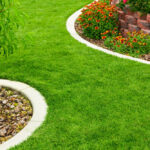
5 Reasons to Install a Smart Irrigation WiFi Controller
September 5, 2023
When Should I Start Up My Sprinkler System?
February 1, 2024A lot of homeowners make the same mistake when it comes to caring for their lawns in fall, and they don’t really take care of them properly, or at all.
They seem to think that lawns need less care during fall, as the grass grows slower before becoming dormant in winter, but fall is exactly when the grass needs proper nutrients and enough moisture the most, so that it can be completely prepared for the cold winter.
In order for you to have a thick and healthy lawn come spring, you need to take really good care of it during fall. If you take the time to do so, you can be sure that your lawn will stay lush and green, and look more beautiful than ever, so take a look at all the necessary steps that you need to take to provide your lawn with everything it needs.
Keep Mowing Your Lawn, but Adjust Your Lawn Mower Height
Although the grass grows slower in fall, you still need to mow it because, if it grows too long it will mat down under all the fallen leaves.
What’s even worse, it will be very vulnerable to cold weather and snow mold. This is why you need to decrease the height of your lawn mower, but make sure you don’t either leave the grass too long or cut it too short.
Cutting your lawn grass too short can be just as bad as letting it grow longer, because it will have fewer roots and it will not be able to withstand cold temperatures and winter dryness. Also, if the grass is too short, weeds can get to it much easier.
Regularly Remove Fallen Leaves
If you don’t rake your lawn during fall to remove all the fallen leaves, they will smother your grass and completely mat it down. More importantly, they will block the light that your grass needs and let in a number of insects that will damage your lawn, not to mention that they will open the door to the first agents of decay – fungi.
When fallen leaves are not removed, they create a thick carpet of decay, which is very harmful to the turf below. When they are decaying, they become soggy and suffocate the grass underneath. They become even soggier because of all the rain and morning dew, especially since there is less evaporation during fall, so it is paramount to remove them regularly in order to let the grass breathe freely.

Aerate the Soil in Your Lawn
The soil in your lawn becomes compacted over time, which is why you need to loosen it and allow the roots of your grass to receive oxygen, water and all the nutrients it needs to stay healthy. In order to effectively improve drainage, you need to aerate your lawn annually, and fall is the best season for doing so.
Make sure that the aerator you use actually extracts plugs from your soil and breaks up thatch, rather than just making holes in it, so that the soil doesn’t actually become more compacted later.
However, when it comes to aeration, you need to take into account your lawn’s grass type, as well as your location. In South Carolina, you should not aerate warm-season grass (Centipede, St. Augustine, Zoysia and Bermuda) during fall, since it is not actively growing then and cannot properly recover from aeration.
On the other hand, Fescue, South Carolina’s cool-season grass, actively grows during fall and spring, but fall is the best time to aerate it, because then you can plant seeds in areas that may have been damaged due to the hot summer weather.
Overseed Your Lawn
Overseeding your lawn during fall will fill in bare patches and result in lush, green and healthy grass in spring. Dead areas make it easier for weeds to take over, which makes overseeding even more important, so make sure you spread the seed over your entire lawn and water it several times a day.
If you live in South Carolina and have a warm-season grass lawn, make sure you overseed it with perennial ryegrass, so that it can be healthy during cold winter months. Fescue also needs overseeding in fall, since it’s not as tough as warm-season grasses, and hot summer weather makes it die out. After overseeding your lawn, make sure you fertilize it, so that you provide it with the necessary nutrients to remain healthy during winter.
Don’t Stop Watering
A lot of people stop watering their lawns in fall, because they think that nature will take its course and the rain will keep the grass roots hydrated. Of course, there is more rain and dew during that time of year, but it is definitely not enough for the grass to receive enough moisture and be well-prepared for winter.
Therefore, make sure you keep watering your lawn even in fall, and do it once or twice per week. It’s ideal to irrigate your soil in the morning, because doing it in the evening will stimulate fungal diseases.
It’s important to make sure that you have a reliable irrigation system, so that you can provide your lawn with the best possible care and, of course, to economically utilize your water. Therefore, it is vital that you know how to choose an irrigation contractor in order to invest wisely and have a beautiful lawn that you can enjoy any time of year.

Taking proper care of your lawn all year round is crucial if you want it to always be healthy and lush. Therefore, make sure you follow all of the aforementioned tips, and don’t forget to take into consideration the type of South Carolina grass that you have, since each and every one of them requires a slightly different type of care. After all, you want your grass to look perfect at all times, so take every factor into account and effectively improve both the appearance and health of your lawn.

